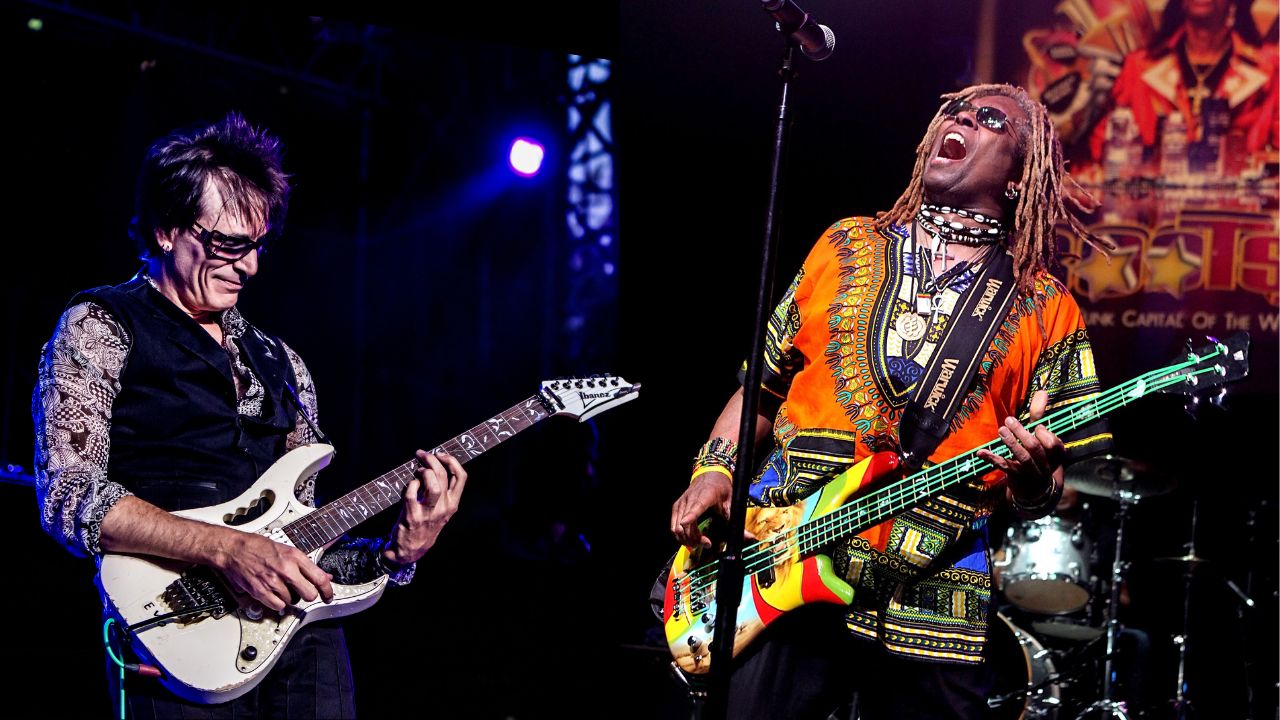“I was scared to death. Miles didn’t say a word to me. Afterwards, I asked what he thought of my playing. He said, simply, ‘It was cool’”: T.M. Stevens on playing with Miles Davis and James Brown – and what went wrong on Vai’s Sex & Religion project
Vai hired the “flashy bassist with the long hair” after spotting him in a Joe Cocker video

Hailing from the Bronx in New York, the late T.M. Stevens recorded with some of the world’s most prestigious artists, from James Brown to Tina Turner. “I've had a strange career,” he told Bass Player back in 2010. “I don’t think it’s because I am a great bass player, it’s because I didn’t know how to say no to a gig!”
Inspired by the sounds of Motown, Led Zeppelin, and Jimi Hendrix, Stevens began playing bass guitar in after-hours clubs when he was 12. “I would get home at 7am, take a shower, and go to school!”
Before long, he was firmly ensconced in the fusion scene, forming a band with Narada Michael Walden and opening for Billy Cobham, among others. He soon added Al Di Meola's group, John McLaughlin's One Truth Band, and a heralded recording session with Miles Davis to his resumé.
In 1993 Stevens played on Steve Vai’s Sex & Religion album. “T.M. Stevens was a force of nature on bass,” said Vai, who paid tribute to Stevens via social media. “I was fortunate enough to have had him play on my Sex & Religion recordings and the Down Deep Into The Pain video with Terry Bozzio and Devin Townsend. I still feel the walls shaking in remembrance of his overall power when he played.”
Released under the band name VAI, the band split up after the album was finished, and Vai subsequently toured without Stevens. So what went wrong?
“Steve's original vision involved a band concept. He had already hooked up with drummer Terry Bozzio, and while in Spain he saw me in a Joe Cocker video. He called the States to find out who the ‘flashy bassist with the long hair’ was.
“When he finally located me, we all got together and jammed, and after 10 notes we knew it was happening. As it turned out, during the recording his vision progressed into more of a solo direction, and it was his record deal; he was very upfront about it, though, so we understood.”
Get The Pick Newsletter
All the latest guitar news, interviews, lessons, reviews, deals and more, direct to your inbox!
This interview from the Bass Player archives took place in June 1996, following the release of Stevens' debut album, Boom!
What did Steve Vai's reaction to you in the Joe Cocker video say about the importance of your image?
“Plenty. I got Little Steven's gig the same way – he saw me in Whitney Houston's I Get So Emotional video and loved all the wildness. I would say that these days, image is at least a third of the entire package. If I say Flea or Bootsy, you conjure up an image of what they look like and play like. So when people think of you, you want them to say, ‘Oh, yeah – he's the guy with A, B, C, and D – get him,’ because they know, or think they know, what you're about, I learned that from people like Sly and George Clinton.”
When did you realize heavy metal funk was your voice?
“As a kid I loved James Brown, Sly Stone, Larry Graham, and P-Funk, but I also dug Hendrix, Led Zeppelin, the Who, and Cream. I was checking out MTV and digging the raw power of metal bands like Metallica, Pantera, and AC/DC; then I started seeing the Chili Peppers, Living Colour, the Dan Reed Network, Bad Brains, Fishbone – bands that added the funk. That inspired me to incorporate those two elements in my own way.”
You've played so many styles of music – what appeals most to you?
“I'm happiest when I'm able to play full-out and really break a sweat, and l've always loved powerful, driving, hardcore music. There's just something about hearing crunch guitars and massive drums that speaks to me, it's the ‘dig-in’ factor. That energy was present at the height of fusion, when I was coming up.”
Tell me about your experience with Miles Davis.
“I was scared to death. We recorded all day long, and Miles didn't say a word to me the whole time. Afterwards, he started play-boxing with me, so I felt brave enough to ask what he thought of my playing. He said, simply, ‘It was cool.’”
“My pride kicked in momentarily and I said, ‘Cool? I played everything perfectly.’ And he said, ‘That's the problem. The brilliance comes in your mistakes – that's how you discover new things. And the only way to make mistakes is to stretch and take chances, If you play it safe, you'll never progress.’
“From that moment on I realized your ears have to be much bigger than your mouth. The band broke up shortly afterwards, but we made some great music.”
Was working with James Brown equally daunting?
“Not quite. First, we recorded the songs at Dan Hartman's house using vintage guitars and keyboards, because James didn't want to sing to high-tech tracks. Then he came in and recorded his vocals alone. Finally, we re-recorded the tracks around his vocals, using active basses and synths.
“I did get to talk with James a few times; his message was that funk isn't just a way of life – it's a religion. The biggest lesson for me, though, was having to go back and listen closely to the bass parts on his old records. I found that I really needed to get the original feel down.”
“Later, when Dan hired me for Joe Cocker's Unchain My Heart and I started funkifying the grooves, I kept that in mind. But Joe liked the fresh approach we were bringing to his music so he refused to let us listen to his old records!”
In between Brown and Cocker, you were a member of the Pretenders.
“Right. I had done a record in L.A. for Bob Geldof with Jimmy Iovine and Bob Clearmountain; they called me and Steve Jordan to come to Woodstock to work on a Pretenders record. I ended up doing most of the album in a day and a half. Chrissie Hynde was very impressed and asked me to join the band; I dug her energy and the punkish feel of the music, so I accepted.
“We did an incredible tour of Europe, but when we got to the U.S., external problems – including the reaction of the press to a musically and racially mixed Pretenders – eventually caused the band to break up.”
What did you learn from that experience?
“Chrissie taught me a lot about relating to audiences. She opened my eyes to the fact that we were playing for people, not just musicians. That, in turn, got me to simplify my own playing. Onstage, she felt overwhelmed by the band and would often ask us not to be so proficient and precise. She would tell me things like, ‘You're not getting paid by the note,’ or, ‘Don't go above the 12th fret.’”
As someone who has cracked many stereotypes, what advice can you give to young bassists?
“Play with as many different people in as many different styles as possible. Listen to the greats for ideas, but don't copy anyone; strive to be original. In general, stay positive, because every musician encounters peaks and valleys.
“When I was in my teens and unsure of a career path, I studied to be a medical lab technician. One day, my professor saw me with headphones on, listening to Hendrix, and he suggested I take a leave of absence. I asked why, and he said, ‘Would you rather be a half-assed lab tech or a great artist?’”
Chris Jisi was Contributing Editor, Senior Contributing Editor, and Editor In Chief on Bass Player 1989-2018. He is the author of Brave New Bass, a compilation of interviews with bass players like Marcus Miller, Flea, Will Lee, Tony Levin, Jeff Berlin, Les Claypool and more, and The Fretless Bass, with insight from over 25 masters including Tony Levin, Marcus Miller, Gary Willis, Richard Bona, Jimmy Haslip, and Percy Jones.
“I was playing stuff I don’t think James Brown understood. He told me, ‘You have to play the one – you’re playing too much’”: Six years after he quit touring, Bootsy Collins reflects on James Brown and George Clinton, and what he gets out of playing today
“When I first heard his voice in my headphones, there was that moment of, ‘My God! I’m recording with David Bowie!’” Bassist Tim Lefebvre on the making of David Bowie's Lazarus










![[from left] George Harrison with his Gretsch Country Gentleman, Norman Harris of Norman's Rare Guitars holds a gold-top Les Paul, John Fogerty with his legendary 1969 Rickenbacker](https://cdn.mos.cms.futurecdn.net/TuH3nuhn9etqjdn5sy4ntW.jpg)


